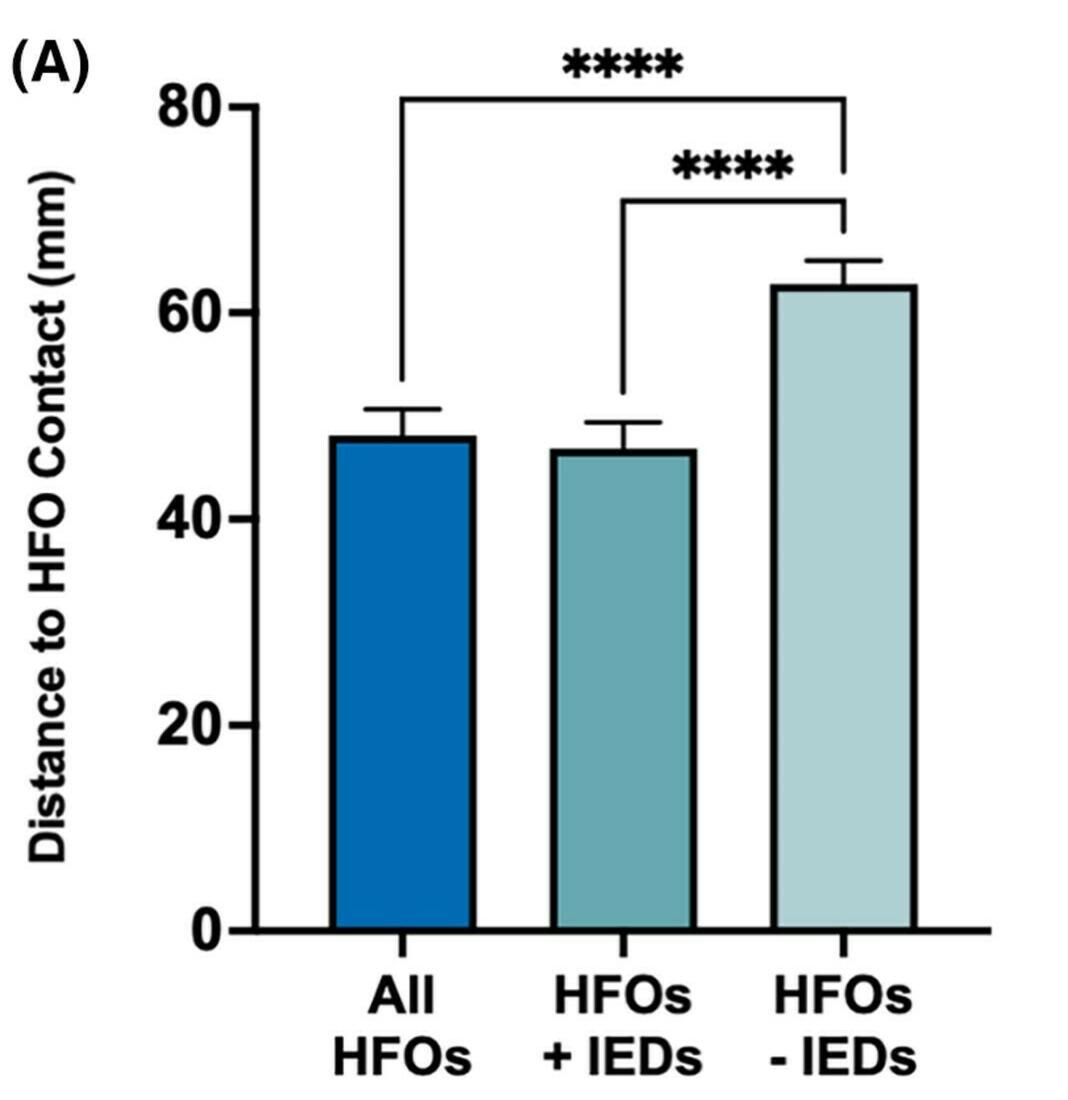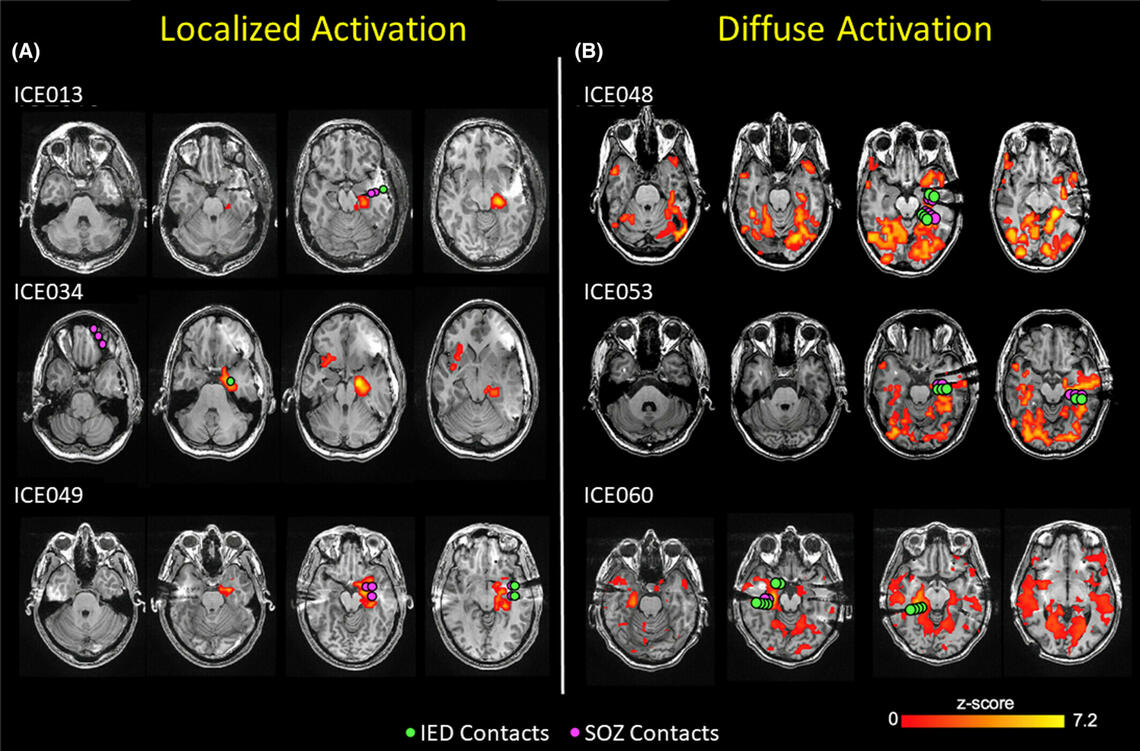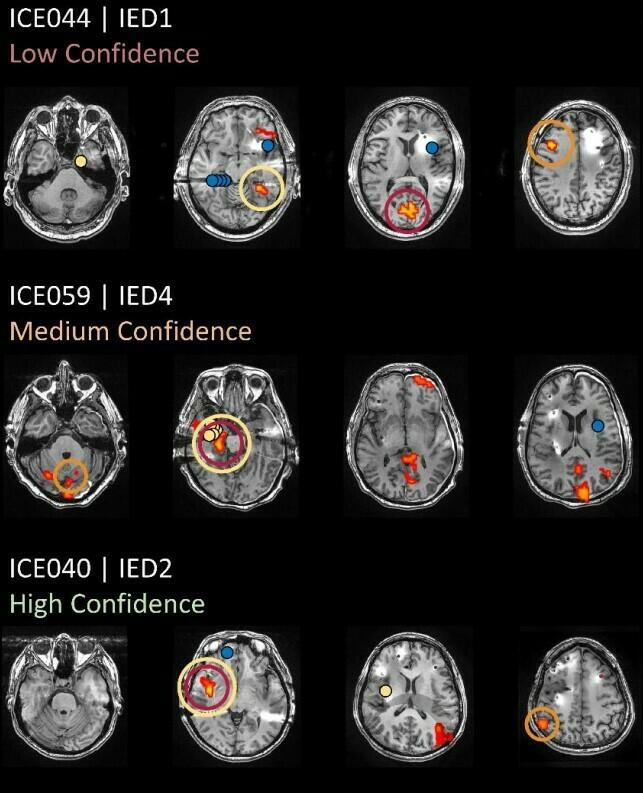Latest Publications
Part of creating important research is translating the findings to the public and experts. Check out summaries of our most recent publications below. We also provide a full list of our publications.
High Frequency Oscillations are Better Markers when Coupled with Interictal Epileptiform Discharges
Wilson W, Pittman DJ, Dykens P, Mosher V, Gill L, Peedicail J, George AG, Beers CA, Goodyear B, LeVan P, Federico P; Calgary Comprehensive Epilepsy Program collaborators

Comparison of localization performance between HFOS without and with IEDs. HFOs without IEDs have clusters that are further away from the HFO origin on EEG compared to HFOs with IEDs.
Recent advances in brain imaging have led to a breakthrough in pinpointing where seizures start in the brain. Our study combines two powerful techniques—EEG and fMRI—to improve how we locate the exact areas responsible for seizures in patients with epilepsy. By focusing on high-frequency brain waves, called high frequency oscillations (HFOs), and their interaction with other electrical disturbances on EEG, we aimed to enhance the accuracy of epilepsy surgery planning.
We studied 45 patients with epilepsy who had electrodes implanted in their brains to monitor electrical activity. While these patients were in an MRI scanner, we used EEG to detect HFOs, which are events that are thought to be precursor events to seizures. We also looked at how these HFOs related to other epileptic tissue marker events called interictal epileptiform discharges (IEDs). Using fMRI, we then mapped the brain's activity during these events to see which brain regions were active when they were occurring.
We found that not only do HFOs cooccurring with IEDs produce unique activation maps, but the resulting fMRI maps show increased activity in areas much closer to the electrodes where HFOs are observed from compared to fMRI maps correlated with HFOs alone. Even more importantly, activation maps associated with HFOs and IEDs together were more discrete and had greater activation than activation maps associated with HFOs alone. Therefore, we show that considering cooccurring HFOs and IEDs can allow for the creation of clearer fMRI activation maps that can be used to better localize seizure generating tissue.
Diffuse fMRI Activation Associated with Interictal Epileptiform Discharge Indicates Better Outcomes
George AG, Beers CA, Wilson W, Mosher V, Pittman DJ, Dykens P, Peedicail JS, Gill L, Gaxiola-Valdez I, Goodyear BG, LeVan P, Federico P; Calgary Comprehensive Epilepsy Program Collaborators
Temporal lobe epilepsy (TLE) remains one of the most challenging forms of epilepsy, particularly when MRI scans fail to reveal any visible lesions, a condition known as non-lesional TLE. Such cases often present significant difficulties in managing seizures and achieving favorable surgical outcomes. In our recent study, we aimed to better understand the underlying brain activity associated with interictal epileptiform discharges (IEDs) in these patients. By leveraging simultaneous intracranial electroencephalography–functional magnetic resonance imaging (iEEG-fMRI), we sought to uncover how these discharges impact brain activation patterns, which could provide new insights into why some patients experience worse outcomes despite surgical interventions.
We looked at 18 patients with non-lesional TLE who were undergoing iEEG monitoring for their condition. Using iEEG-fMRI, we recorded electrical activity from the mesial temporal lobes and simultaneously captured brain activation patterns through functional MRI. This dual-modality approach allowed us to identify the hemodynamic changes, indicative of brain activation, associated with IEDs. We analyzed the fMRI data to determine activation patterns and then investigated if specific activation patterns relate to clinical features of seizures and surgical outcomes of resective surgery.

A comparison between localized and diffuse fMRI IED associated activation maps for six patients in our study.
Our findings revealed two distinct patterns of IED-associated brain activation: primarily localized, where activation was confined to the temporal lobe where IEDs were recorded, and primarily diffuse, where activation spread widely across both hemispheres of the brain. Patients with diffuse activation patterns demonstrated significantly better outcomes. Specifically, those with widespread activation experienced fewer focal to bilateral tonic–clonic seizures and had better results following surgery. Notably, 73% of patients with diffuse activation reported fewer than one focal to bilateral tonic–clonic seizure per month, and 85% had favorable surgical outcomes. These results suggest that diffuse activation may be indicative of a neuroprotective mechanism that helps limit the spread of seizures, potentially improving surgical success. Ultimately, we show the utility of iEEG-fMRI in providing a more comprehensive view of brain activity in non-lesional TLE, and potentially such investigations can be used to better tailor treatment approaches for non-lesional TLE patients.
Cluster Confidence can Predict Poor Surgical Outcome of Resective Epilepsy Surgery
Wilson W, Tehrani N, Pittman DJ, Dykens P, Mosher V, Gill L, Peedicail J, George AG, Beers CA, Goodyear B, LeVan P, Federico P; Calgary Comprehensive Epilepsy Program collaborators.
Functional imaging techniques have long been crucial in understanding the complex dynamics of epilepsy, particularly through simultaneous scalp EEG and fMRI (EEG-fMRI) studies initiated in the 1990s. These studies have demonstrated that maximum blood oxygen level-dependent (BOLD) responses to interictal epileptiform discharges (IEDs) can localize potential epileptogenic zones, aiding in pre-surgical evaluations. Despite these advances, the clinical adoption of EEG-fMRI has been limited due to several challenges, including a significant proportion of non-informative results and difficulties in interpreting diffuse activation maps. Early studies highlighted the potential of BOLD responses in predicting post-surgical outcomes, yet subsequent research with larger cohorts has shown more modest performance metrics. We aimed to examine the utility of both objective and subjective methods of analyzing the results of intracranial EEG-fMRI in localizing regions relevant to seizure generation.

Examples of low-, medium-, and high-confidence clusters across three different patients. Circled in dark red are the most active clusters, with the orange circles highlighting comparison clusters that are used to determine confidence.
In our study, 70 patients with drug-resistant focal epilepsy underwent simultaneous intracranial EEG-fMRI monitoring. Brain activation associated with IEDs appearing on intracranial EEG was imaged using fMRI to create clustered activation maps. We examined these clusters subjectively using a epileptologist's expertise to identify "clinically relevant" clusters. An objective examination was also done by looking difference in activation between the most activated cluster and other clusters, with greater differences in significance indicating a higher degree of confidence that the most active cluster was indeed the most relevant clinically. We categorized the degree of confidence into 3 categories: low, medium, and high.
We found that only the confidence based method of identifying relevant clusters resulted in an association between resection of the cluster and good post-surgical outcome. The resection of medium- and high-confidence clusters was correlated with improved outcomes, although it did not guarantee seizure freedom. However, the failure to resect these high-confidence clusters had a strong negative predictive value, with all patients with unresected high-confidence clusters having poor surgical outcomes. These results not only highlight the need for refined methods in identifying relevant information form intracranial EEG-fMRI studies, but also a possible approach to the issue that can enhance surgical planning and improve patient outcomes.
